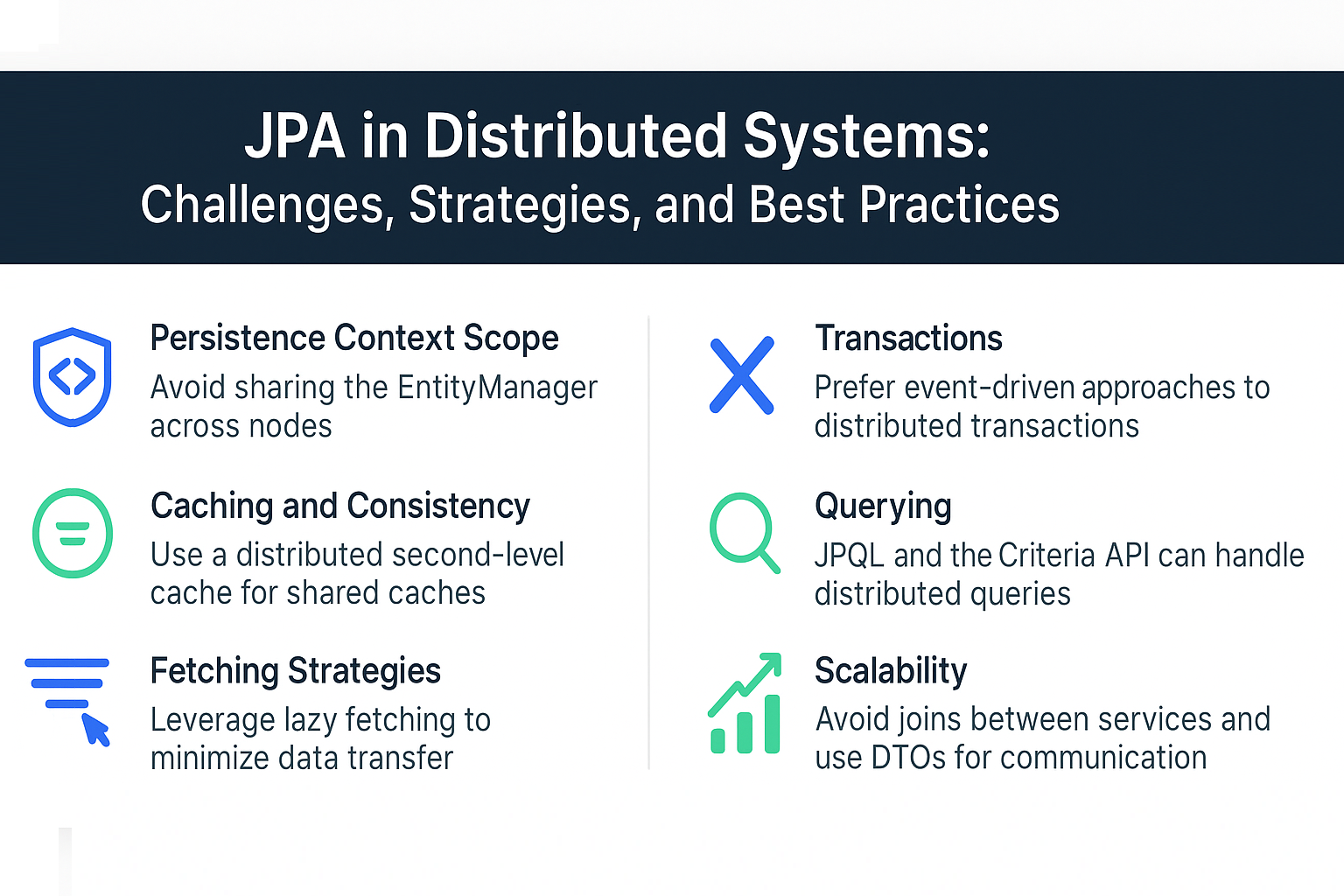Distributed systems are the backbone of modern enterprise applications. They span across multiple servers, data centers, or even geographical regions. While JPA (Jakarta Persistence API) provides a convenient abstraction over relational databases, its behavior changes significantly in distributed environments.
Using JPA in distributed systems requires understanding persistence context management, caching, concurrency, and replication. Think of distributed JPA like a group project across multiple campuses: without coordination, conflicts and inconsistencies are inevitable.
This tutorial explains how to effectively use JPA in distributed systems, highlighting challenges, solutions, and best practices.
Core Challenges of JPA in Distributed Systems
- Persistence Context Scope: EntityManager is local to a single JVM; managing it across services is tricky.
- Caching and Consistency: Second-level caches must synchronize across nodes.
- Transactions: Distributed transactions (XA) are expensive and complex.
- Replication Lag: Reads from replicas can show stale data.
- Scalability: Excessive eager fetching or N+1 queries multiply issues across distributed nodes.
Setting Up JPA in Distributed Systems
Example persistence.xml
<persistence xmlns="https://jakarta.ee/xml/ns/persistence" version="3.0">
<persistence-unit name="distributedPU">
<provider>org.hibernate.jpa.HibernatePersistenceProvider</provider>
<properties>
<property name="jakarta.persistence.jdbc.url" value="jdbc:mysql://cluster-db:3306/distributed"/>
<property name="jakarta.persistence.jdbc.user" value="dbuser"/>
<property name="jakarta.persistence.jdbc.password" value="password"/>
<property name="hibernate.hbm2ddl.auto" value="validate"/>
<property name="hibernate.cache.use_second_level_cache" value="true"/>
<property name="hibernate.cache.region.factory_class" value="org.hibernate.cache.jcache.JCacheRegionFactory"/>
</properties>
</persistence-unit>
</persistence>
Persistence Context in Distributed Systems
- Local per-service persistence context = classroom attendance register.
- Do not try to share EntityManager across nodes.
- For long-running workflows, use sagas or event-driven patterns, not extended persistence contexts.
Customer customer = em.find(Customer.class, 1L);
em.detach(customer); // Useful when transferring entities across service boundaries
CRUD Example in Distributed Microservice
@Stateless
public class CustomerService {
@PersistenceContext
private EntityManager em;
public void createCustomer(Customer c) {
em.persist(c);
}
public Customer getCustomer(Long id) {
return em.find(Customer.class, id);
}
public Customer updateCustomer(Customer c) {
return em.merge(c);
}
public void deleteCustomer(Long id) {
Customer c = em.find(Customer.class, id);
if (c != null) em.remove(c);
}
}
Each service instance runs independently with its own persistence context.
Querying in Distributed Systems
JPQL
List<Customer> customers = em.createQuery("SELECT c FROM Customer c WHERE c.name LIKE :name", Customer.class)
.setParameter("name", "John%")
.getResultList();
Criteria API
CriteriaBuilder cb = em.getCriteriaBuilder();
CriteriaQuery<Customer> cq = cb.createQuery(Customer.class);
Root<Customer> root = cq.from(Customer.class);
cq.select(root).where(cb.like(root.get("name"), "John%"));
List<Customer> results = em.createQuery(cq).getResultList();
Caching in Distributed Systems
- First-Level Cache: Always local to
EntityManager. - Second-Level Cache: Requires distributed cache like Hazelcast, Infinispan, or Redis.
Example: Hazelcast Configuration
<property name="hibernate.cache.region.factory_class" value="com.hazelcast.hibernate.HazelcastCacheRegionFactory"/>
This ensures cache consistency across cluster nodes.
Fetching Strategies and Performance
- Use Lazy fetching as default.
- Avoid cross-service joins; services should not query each other’s schemas.
- Use DTO projections for inter-service communication.
- Apply batch fetching to reduce round trips.
Real-World Use Cases
- Banking Systems: Each service (Accounts, Transactions) uses JPA independently with an event-driven sync.
- E-Commerce Platforms: Order, Payment, and Inventory services each manage their own persistence units.
- Distributed Analytics: JPA used for transactional data, with replication to data lakes for analysis.
Common Pitfalls
- Shared Database Across Microservices: Leads to tight coupling.
- Over-reliance on XA Transactions: Hurts scalability. Prefer eventual consistency.
- Eager Fetching in Distributed Systems: Causes massive data loads.
- Unmonitored Caches: Lead to stale or inconsistent data.
Best Practices
- Use event-driven communication (Kafka, RabbitMQ) instead of distributed transactions.
- Prefer optimistic locking to reduce contention.
- Keep persistence contexts short-lived per request.
- Use DTOs and APIs to exchange data between services.
- Apply circuit breakers when accessing remote services.
📌 JPA Version Notes
-
JPA 2.0
- Criteria API and Metamodel introduced.
-
JPA 2.1
- Entity graphs, stored procedures.
-
Jakarta Persistence (EE 9/10/11)
- Namespace migration (
javax.persistence→jakarta.persistence). - Improved CDI integration for microservices and distributed systems.
- Namespace migration (
Conclusion & Key Takeaways
- JPA works well in distributed systems if services maintain database and persistence isolation.
- Use distributed caching, event-driven sync, and DTO projections to avoid cross-service coupling.
- Avoid XA where possible; embrace eventual consistency.
- Treat caching and persistence context management as critical to scalability.
FAQ
Q1: What’s the difference between JPA and Hibernate?
A: JPA is a specification, Hibernate is an implementation.
Q2: How does JPA handle the persistence context?
A: Like a register, it tracks managed entities, local to one service instance.
Q3: What are the drawbacks of eager fetching in JPA?
A: Loads unnecessary data, especially costly in distributed environments.
Q4: How can I solve the N+1 select problem with JPA?
A: Use JOIN FETCH, batch fetching, or entity graphs.
Q5: Can I use JPA without Hibernate?
A: Yes, with EclipseLink, OpenJPA, or other providers.
Q6: What’s the best strategy for inheritance mapping in JPA?
A: SINGLE_TABLE for performance, JOINED for normalization.
Q7: How does JPA handle composite keys?
A: Using @EmbeddedId or @IdClass.
Q8: What changes with Jakarta Persistence?
A: Migration to jakarta.persistence, aligning with Jakarta EE.
Q9: Is JPA suitable for microservices?
A: Yes, if each service maintains database-per-service and uses DTOs.
Q10: When should I avoid using JPA?
A: For distributed analytics or high-volume streaming; prefer specialized tools.
